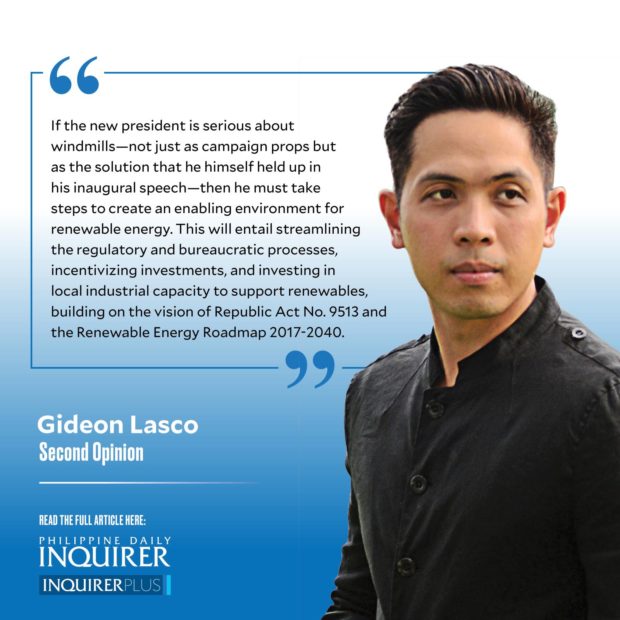Windmills beyond symbols

“I built them,” he emphatically said, casting himself as a builder in the mold of his father, who he extolled in the same speech as someone who “built more and better roads.”
The disingenuousness notwithstanding, might he at least be encouraged actually to make clean energy a centerpiece of his administration? Baka naman panindigan n’ya? After all, he did acknowledge the urgency of the climate crisis, and even took cognizance of the fact that “we are the third biggest plastics polluter in the world,” vowing that “we will clean up.”
Article continues after this advertisementIf so, the windmills are a step in the right direction.
A baby step, that is. The fact that the windmills in our country—whether the 20 units in Bangui, 50 in Burgos, or 27 in Pililla—remain “tourist destinations” speaks of how novel they remain in our country, whereas they are viewed as a regular part of the landscape elsewhere, an eye sore even, for instance, here in California, where just one wind farm can have thousands of turbines.
Indeed, to put things in perspective, the United States has over 70,000 wind turbines and the United Kingdom has over 11,000, while our country—which is bigger than the UK in terms of land area—has less than 200. In terms of installed wind power capacity, ours (443 megawatts) is dwarfed by neighbors like Thailand (1.5 gigawatts) and Vietnam (4 gigawatts), with the latter taking the lead in offshore wind farms in the region, even as it was behind us in terms of wind power just a few years ago.
Article continues after this advertisementIndeed, many countries are embracing wind power at a dramatic rate, spurred by the significant drop in the cost of generating wind power, with the technology and materials to make it now more efficient and affordable than ever. All these developments have made wind power one of the most cost-effective energy sources available today.
The increasing urgency of ending our dependence on fossil fuel is also creating a renewed impetus for the push for clean energy and a decarbonized economy, making wind power not just economically but politically sound. The latest report from the Intergovernmental Panel on Climate Change released last April has called for more wind and solar power, projecting that these two sources combined can furnish one-third of the emission reductions needed to keep the global temperature increase to 1.5 degrees Celsius.
Finally, from an energy security perspective, the fact that wind power has no fuel costs makes it more stable and thus preferable to fossil fuel sources, in which the prices are often at the mercy of world political events, for instance, the ongoing Russian invasion of Ukraine.
Of course, some challenges prevent energy from being scaled in the Philippines; while our land area is larger than the UK, not all of the land is suitable for wind power, and typhoons and other calamities can also narrow viable sites—even as typhoon-proof wind turbines are now being developed. Notwithstanding these challenges, technical reports (for instance, a new wind energy road map released by the Department of Energy and the World Bank in April) estimate that the country has the potential to have 21 gigawatts of offshore wind power, on top of onshore projects.
If the new president is serious about windmills—not just as campaign props but as the solution that he himself held up in his inaugural speech—then he must take steps to create an enabling environment for renewable energy. This will entail streamlining the regulatory and bureaucratic processes, incentivizing investments, and investing in local industrial capacity to support renewables, building on the vision of Republic Act No. 9513 and the Renewable Energy Roadmap 2017-2040.
It will also require appointing qualified individuals in the relevant government agencies and supporting homegrown expertise—e.g., scientists and engineers—that we need to build and operate wind projects.
Finally, it will involve decisively and definitively saying no to coal-fired power plants and ending the dominance of fossil fuels in our country’s energy fix.
Suppose Mr. Marcos can make clean energy a priority of his administration, leading to windmills actually powering a significant proportion of our energy needs. In that case, perhaps, he can finally, truthfully, say: “I built them.”
—————-
glasco@inquirer.com.ph
















